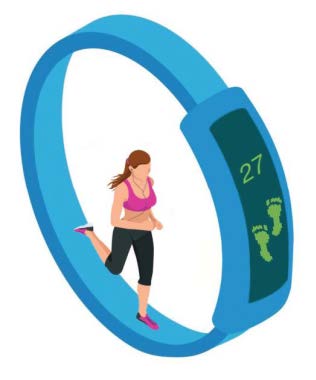10,000 Steps Versus Exercise
Remember that you are also setting an example for your children. Demonstrating healthy habits will teach kids to incorporate these activities as they grow.
You may have heard about the studies that show sitting is worse for your health than smoking, and to combat this, getting a certain number of steps in per day is recommended. Our occupations are more sedentary than they used to be, and our pastimes are also getting less active as we sit at our computers and on our devices more often. Before Wall-E becomes our reality, health care providers are encouraging people to get at least 10,000 steps per day.
There are devices and apps that can count your steps; they can alert you when you are on track, or need a reminder to get moving. While this 10k steps per day is a great guideline, do not replace your exercise routine with getting your steps in. Walking is great – it gets you upright, boosts your circulation, and loosens up your muscles. However, remember that exercise is defined by intensity.
The definition of exercise is "physical activity that is planned, structured and repetitive for the purpose of conditioning any part of the body. Exercise is used to improve health, maintain fitness and is important as a means of physical rehabilitation." The reason this is important is because exercise goes above and beyond your daily activities. Doing housework or yard work is physical activity, but it's not exercise. Getting 10,000 steps in a day is actually a recommendation for your daily activity! It is meant to encourage you to walk rather than drive to a local store, and walk at the airport rather than riding the people mover. The difference between daily activities and exercise can often be clarified by considering the intensity at which you feel like you're working. Let's focus on cardiovascular exercise, also known as aerobic exercise. This is pushing a wheelchair, swimming, cycling, dancing, etc. It's activity that can be sustained and improves your endurance. Aerobic exercise enhances glucose regulation (i.e. helps manage or prevent diabetes,) improves blood pressure and improves arterial function. It can also help improve your memory and decrease depression and anxiety.
Heart rate is one way to monitor your intensity, however there are a number of factors that can impact your heart rate's response to exercise. There are medications that may impact heart rate; if you have a condition that impacts your autonomic system, your heart rate response may not be reliable; etc. Rather than getting a heart rate monitor, or figuring out how to take your pulse while working out, there is a simple 1-10 scale that you can use.
1 = resting, probably how you feel now. 10 is that all out sprinting effort that can't be sustained for very long. For aerobic exercise, you need to push yourself into the 4-6 range. It should feel effortful, and you may be short of breath, but could still have a conversation. If you're not getting tired by the exercise, it probably is in that 2-3 range. Housework and yard work is in this 2-3 range.
Your level of effort is unique to you. Your 5 may be different than your spouse's 5. Think about this scale the next time you're exercising – and if you are not reaching that 4-6 level, think about how to get up into that zone (safely!) As your fitness improves, it will take more work to get to the same intensity. That's great! It means you're getting stronger and reaping the benefits of your workouts. But it also means you can't get complacent with your exercise routine, and you'll need to step it up.

If you can push your walking to an intensity that constitutes exercise, fantastic! You can do this by walking faster, or by adding small weights to increase the effort. weights to increase the effort. Still thinking about that 1-10 scale? You may feel a little short of breath, and it may be effortful to carry on a conversation – that is good! This is when you are getting the cardiac and neurological benefits. While I agree with the importance of being upright as much as possible, taking 10,000 steps is not possible for everyone. Getting the steps does not lessen the need to push the intensity and get enough exercise! Remember that you are also setting an example for your children. Demonstrating healthy habits will teach kids to incorporate these activities as they grow. Make it a family activity! Have challenges between family members to win something – like control over what plays in the car for a week, or picking the family dinner for three nights. Have fun with the exercising as well as the rewards.•
